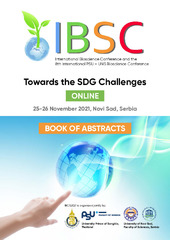Приказ основних података о документу
Proline-based deep eutectic solvents as greener alternative for obtaining polyphenol rich extracts of Satureja kitaibelii
| dc.creator | Arsenijević, Jelena | |
| dc.creator | Kovačević, Nada | |
| dc.creator | Drobac, Milica | |
| dc.creator | Ražić, Slavica | |
| dc.creator | Emhemmed, Fathi | |
| dc.creator | Muller, Christian | |
| dc.creator | Marcic, Christophe | |
| dc.creator | Marchioni, Eric | |
| dc.date.accessioned | 2023-10-11T13:36:36Z | |
| dc.date.available | 2023-10-11T13:36:36Z | |
| dc.date.issued | 2021 | |
| dc.identifier.uri | https://farfar.pharmacy.bg.ac.rs/handle/123456789/5103 | |
| dc.description.abstract | INTRODUCTION: Aerial parts of Satureja kitaibelii Wierzb. ex Heuff. (Lamiaceae), in Serbia known as Rtanj’s tea, are traditionally used to treat various respiratory, urinary and other health disorders. Extracts of this herb exhibit a significant bioactivity as well37. Using deep eutectic solvents (DESs) for extraction of certain phenolic compounds is in line with the principles of green chemistry38. However, the toxicity of DESs must be considered39. OBJECTIVES: The main objectives of this work are to assess the polyphenol-extracting ability of proline (Pro) and sugar/sugar alcohol based natural DESs from commercially available Rtanj’s tea, as well as to evaluate cytotoxicity of these solvents against AsPC- 1 cells. METHOD / DESIGN: Accurately weighed Pro and sugar/sugar alcohol, were dissolved in water, frozen, and freeze-dried. The obtained seven DESs (i.e. Pro with: glucose 1:1 and 5:3, fructose 1:1 and 5:3, sorbitol 1:2, and sucrose 2:1 and 3:2) were mixed with water (30%, m/m). Polyphenol extraction was examined using commercial sample of Rtanj’s tea (manufacturer Bojan Radosavljević, Boljevac). Powdered herb (particle diameter 100-200 μm) was extracted by sonication during 30 min at room temperature with the obtained aqueous DESs (herb-to-solvent ratio 1:20), as well as with water, absolute ethanol, or 50% (v/v) ethanol under the same conditions. The qualitative analysis of extracts was conducted by both HPLC and LC-MS. The content of the identified marker compounds in the extracts, i.e. rosmarinic acid (RA) and clinopodic acid O (CAO), was determined by external calibration using RA as the standard compound. Cytotoxicity of the aqueous DESs against human pancreatic adenocarcinoma cells AsPC-1 was tested at four concentration levels (5-25%), after 48 h of incubation and propidium iodide staining. The analysis on Guava® easyCyte 12HT Benchtop flow microcapillary cytometer, was performed afterwards, using InCyte® software package. RESULTS: Upon freeze-drying, mixtures had glassy appearance and transformed into liquids after mild heating. All obtained DESs were highly viscous, and therefore mixed with water. Qualitative LC-MS analysis of 50% ethanol extract revealed the presence of phenolic acids, flavonoids, and jasmonic acid derivatives. Among phenolic acids, the dominant compounds were caffeic acid oligomers RA and CAO. Among conventional solvents, 50% ethanol was better extracting agent than absolute ethanol or water for both RA (88.2 μg/mL) and CAO (116.8 μg/mL). Water extract was also abundant with CAO (106.7 μg/mL), but contained moderate amount of RA (21.7 μg/mL). It is noteworthy to mention that the extraction with ethanol resulted in very low yield of both phenolics, with CAO concentration, being even below detection limit in the absolute ethanol extract. Concentration of RA in the tested DES extracts was higher than corresponding one in the water extract, but lower than in the 50% ethanol extract, and varied in the range from 61.6 μg/mL (in Pro-fructose 1:1 extract) to 85.6 μg/mL (Pro-glucose 1:1 extract). The extraction of CAO, with six out of seven aqueous DESs, was more efficient than with 50% ethanol, resulting in CAO concentration range from 119.6 μg/mL, in Pro-sucrose 3:2 extract, to 172.4 μg/mL, in Pro-glucose 1:1 extract. Pro-fructose 1:1 extract had the lowest content of CAO (86.7 μg/mL) among the tested DESs. At the lowest tested concentration (5%), aqueous DESs did not significantly affect survival of AsPC-1 cells in comparison to the untreated cells (83.1-90.0% and 86.6% of cells remained viable, respectively). Both proline-glucose DESs demonstrated the lowest toxicity. However, at the highest concentration (25%) all aqueous DESs caused death of more than 70% of AsPC-1 cells. CONCLUSIONS: The obtained results indicate that proline and sugar/sugar alcohol based deep eutectic solvents are good extracting agents for phenolic compounds, especially for higher caffeic acid oligomers such as clinopodic acid O. Additionally, low cytotoxicity of tested DESs is a good starting predictor of their safety and potential usage. | sr |
| dc.language.iso | en | sr |
| dc.publisher | University Prince of Songkla, Thailand | sr |
| dc.publisher | University of Novi Sad, Faculty of Sciences, Serbia, Novi Sad | sr |
| dc.relation | info:eu-repo/grantAgreement/MESTD/inst-2020/200161/RS// | sr |
| dc.rights | openAccess | sr |
| dc.source | The International Bioscience Conference and the 8th International PSU – UNS Bioscience Conference - IBSC2021 Book of Abstracts | sr |
| dc.subject | DES | sr |
| dc.subject | cytotoxicity | sr |
| dc.subject | extraction | sr |
| dc.subject | caffeic acid oligomers | sr |
| dc.subject | Satureja L. | sr |
| dc.title | Proline-based deep eutectic solvents as greener alternative for obtaining polyphenol rich extracts of Satureja kitaibelii | sr |
| dc.type | conferenceObject | sr |
| dc.rights.license | ARR | sr |
| dc.citation.spage | 31 | |
| dc.citation.epage | 33 | |
| dc.description.other | The International Bioscience Conference and the 8th International PSU – UNS Bioscience Conference - IBSC2021, Novi Sad, 25th to 26th November 2021 | sr |
| dc.identifier.fulltext | http://farfar.pharmacy.bg.ac.rs/bitstream/id/14096/Proline-based_deep_eutectic_pub_2021.pdf | |
| dc.identifier.rcub | https://hdl.handle.net/21.15107/rcub_farfar_5103 | |
| dc.type.version | publishedVersion | sr |

